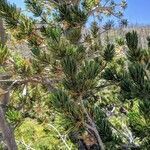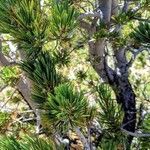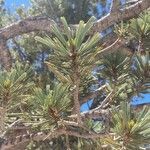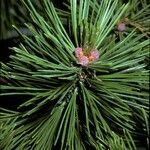A soft pine. It is small and upright and with many stems. It can be low lying at high altitudes. It can form a single stemmed tree 20 m high and with a trunk 50 cm across under good growing conditions. The needles are in bundles of 5 and are 4-9 cm long. They are stout and stiff. They are slightly curved and dark yellowish-green. They are clustered towards the edges of the twigs and the edges are smooth. The needles remain on the tree for 4-8 years. The cones are round and 5-8 cm long. They occur at right angles to the branch. There are 30-50 scales and they are thick, tough and pointed. They do not have prickles. The cones only open slightly at maturity. Cones fall off. The seeds are large and 10 mm long. They are wingless. They have a heavy seed coat.





